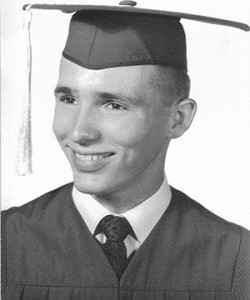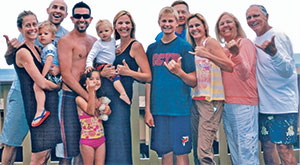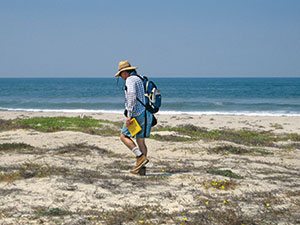There’s yin and yang, peanut butter and jelly, Lennon and McCartney — and then there’s Rust and Reierson. But that partnership might not have happened if it wasn’t for Dr. Walter Ebeling, a fellow Hall of Famer (Class of 2003) known by many as the father of urban entomology.
Don Reierson, a native Californian who was born in Pasadena, was studying to become a high school biology teacher at the University of California, Los Angeles (UCLA) when he answered a job posting for a student assistant to Ebeling in 1962. Soon Reierson was maintaining and studying cockroaches. The former Eagle Scout entered UCLA’s graduate entomology program and worked with Dr. John Belkin, studying mosquitos and other insects important to public heath.
Belkin told Reierson the only way to earn a Ph.D. with him was to sacrifice his job with Ebeling and work full-time as doctoral student. Newly married, Reierson couldn’t afford to do that financially. He continued working with Ebeling, transferred schools and earned a master’s degree at Long Beach State, where his wife, Sandra, also earned a master’s degree in education.
Ebeling and Reierson, who spent summers as a boy working on his grandparents’ farm in South Dakota, worked together for 11 years studying the practical aspects of cockroach control, including insecticide effectiveness and mode-of-action trials. But in 1975, Ebeling retired, and UCLA closed the entomology department — splitting it between the University of California, Riverside and the University of California, Davis.
Reierson chose Riverside, and when he arrived on campus, the university was in process of replacing Ebeling. That person was Mike Rust, a young Ph.D. from the University of Kansas who studied under Dr. William Bell, professor of entomology. Reierson, a research scientist, was assigned to support Rust.

Rust and Reierson’s relationship is tight: They’re on the same wavelength and people reference them together.
“He was young, intelligent, capable and enthusiastic,” Reierson says of Rust, his Hall of Fame colleague (Class of 2007). “We got along especially well. Mike hadn’t had a full-time academic position before this one, and I had been there 11 years. We were off and running. Academia was this whole publish-or-perish thing, and Mike was going to be examined and tested a lot before he was to be granted tenure. I was eager to help him earn it, which he did on the first try within five years. I helped him build and organize his lab, and did everything I could to help him get his research published. Being published is the ultimate. We do it to publicize information and have our research findings available to the public.”
Besides his own unique areas of interest, Rust continued and expanded the work of Ebeling because he realized the importance of Ebeling’s groundbreaking urban entomology research — and the value of working with pest management professionals (PMPs). Reierson, too, liked laboratory and field work, as well as pest management in outdoor wildlife and recreational areas.
Rust and Reierson’s relationship is tight: They’re on the same wavelength, people reference them together. They attend conferences together, they’ve run marathons together, their families are friends, and they’ve worked together more than 35 years.
Field work
Besides his research on termites and fleas, two areas of study Reierson has focused on throughout his career are cockroach and Argentine ant control. With both, he has focused on the biology and behavior of the pests, as well as the potential products used to control them and how to maximize that. Many of the products they’ve investigated and screened were unregistered, numbered experimental insecticides — a few of which were eventually registered for use by PMPs. He has monitored insecticide resistance and documented which products were and were not affected by resistance; he also has researched various ways to combat that. His studies have proven that small amounts of pesticides are often better than large amounts — specifically, lower concentrations of thiamethoxam and fipronil.
“It’s counterintuitive that less is better, but that’s usually the case,” he says. “We’ve used the same concept for the past 15 to 20 years. Initially, we tested the concept on cockroaches, but expanded the concept to several other pest insects as well.”
Reierson also has researched areawide control of yellowjackets, determining which nasty wasps are pests and which ones aren’t. For western scavenging species, he developed an areawide control program for multiple acres — not just in back yards but in specialty areas such as around schools and in waterparks, vineyards and orchards.
With much of his research, Reierson conducts initial tests of ideas in Rust’s lab, then tests them in the field to confirm effectiveness and mode of action. He calls PMPs or property owners to assist him when testing materials.
“We worked with PMPs who couldn’t get the unregistered material we were testing unless they had special permission,” he says. “Those PMPs were the first to know something was coming.”
For example, Reierson was testing a fipronil bait on Argentine ants on the Channel Islands off the cost of Santa Cruz. The PMPs who were helping him wanted to try it on their own, but the bait wasn’t registered yet.
At one point, repellency was becoming an big issue for the industry, so the Rust-Reierson team developed the choice box, which was used to study repellents among various insect populations. When chemical resistance was problematic, Reierson helped developed a spray strategy to counter the problem.
Mentoring
In addition to Rust, Reierson has learned from various mentors in the industry throughout the years. Among the many are:
- Mike Katz and the team of research entomologists at Western Exterminator who assisted in several of Reierson’s research projects;
- Corky Mizer, owner of San Diego-based Corky’s Pest Control;
- Dr. Gary Bennett, a fellow Hall of Famer (Class of 2006) who has given him tips on making contacts in the field and getting good cooperation from PMPs; and
- Pat Copp from Orkin, who has worked on many cockroach and ant control projects and has helped bridge the gap between scientists and PMPs.
On the flip side, Reierson was mentor to many academics in the industry, including professors Dr. Jules Silverman at North Carolina State University, Dr. Arthur Appel at Auburn University, and Dr. Linda Bui at Louisiana State University.
“We became very close with almost every graduate student Mike took on,” he says. “I’m proud of when people say I’m an extension of Mike. I tend to be more available because Mike is so busy, and the students and I are constantly in the lab together. One of my roles was to test the students’ ideas and help develop them in the lab.”
Thankful and content
Even though Reierson retired in 2007, he was on rehire for two-and-a-half years with UC-Riverside.
“They couldn’t keep me on rehire any longer,” he says. “But six months ago, the university asked me to consider returning part time — 45 percent time is the maximum you can work on rehire. In the meantime, I volunteer and help Mike some, but I prefer to be paid. Mike is considering starting two grants on which I would assist and help organize and run.”
An avid jogger (actually a Boston Marathoner), Reierson enjoys traveling, especially to Hawaii once a year. In 1999, he received a medical scare when he was diagnosed with an acoustic neuroma, a brain tumor that was removed. The benign tumor left him deaf in one ear, but he considers himself lucky to have no other lasting effects.
He’s also thankful for his career and history with Rust.
“I’ve traveled all over the world doing urban entomology work,” he says. “Mike has given me the freedom and confidence to do such work.
Throughout the years, Reierson never entertained the idea of leaving the industry, or even taking a different job within it. He was approached by the industry several times, and the state asked him to work for it, but he was having too much fun.
“I couldn’t think of a better working environment,” he says. “I’m very content with where I am. If Mike had left the university or changed direction, things might have been different.”
PMP Hall of Fame Class of 2014
Name: Don Reierson
Organization: University of California at Riverside (retired)
Title: Staff Research Associate, Department of Entomology, University of California-Riverside (retired)
Years in pest management: 52
Industry mentors: Mike Katz, Corky Mizer and Dr. Gary Bennett, among others
Key positions held: staff research associate, department of entomology, University of California-Riverside
Crowning achievements: work with cockroaches (biology, behavior and control); work with Argentine ants (biology, behavior and control); work with yellowjackets (identification and area-wide control)
You can reach John Walsh, a PMP contributor, at jwalsheditor@gmail.com.




Leave A Comment